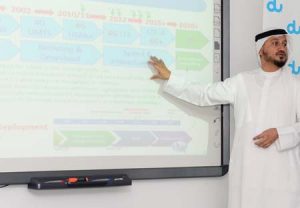Du held a Telecom Knowledge Series session on 5G to highlight latest trends and updates related to this emerging technology. Held at du headquarters and led by Saleem AlBlooshi, dus Executive Vice President of Network Development and Operations, the session projected reaching 5G commercialisation beyond 2020 with some prototypes and trials predicted to begin by […]

Du held a Telecom Knowledge Series session on 5G to highlight latest trends and updates related to this emerging technology. Held at du headquarters and led by Saleem AlBlooshi, dus Executive Vice President of Network Development and Operations, the session projected reaching 5G commercialisation beyond 2020 with some prototypes and trials predicted to begin by 2018.
The Telecom Knowledge Series session followed the approval by the International Telecommunications Union (ITU) of dus paper on 5G standardisation, titled Proposal to launch the 5G studies in SG13. The contribution outlines dus research on the basic and most important requirements for the road to 5G, its current candidate technologies and architecture, and the concerns and issues that the telecommunications provider foresees with them.
Dus recent launch of the first LTE-Advanced (LTE-A) live network in the UAE, forms a significant step on the road towards 5G. We are proud of our successful contribution to the ITU Study Group led by Dr. Mahmoud Sherif from du, and we believe that it cements our objective to be the first in market for pioneering technologies that pave the way towards a 5G future, said AlBlooshi.
The purpose of the Telecom Knowledge Series session was to highlight the unique nature of 5G technology, the evolution from 4G to 5G networks, and the future of the 5G ecosystem and its requirements. In addition, the session gave an overview of the future stages of 5G leading to its projected launch.
The session highlighted that 5G should be viewed as the overall future solution for providing next generation mobile services to both people and devices. The infrastructure provided by 5G networks will have the ability to support a very large number of connected devices, always provide online connectivity, operate for optimum energy efficiency and support flexible air interfaces.














































































